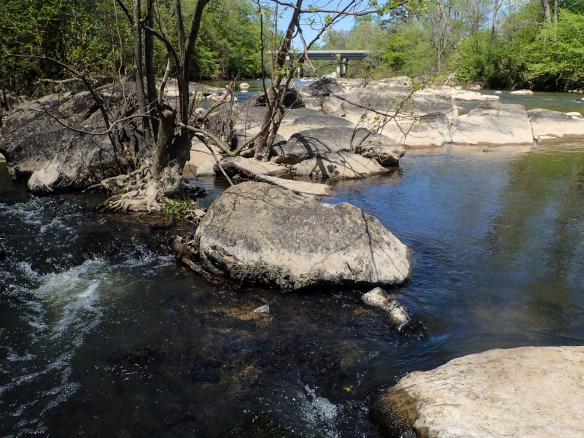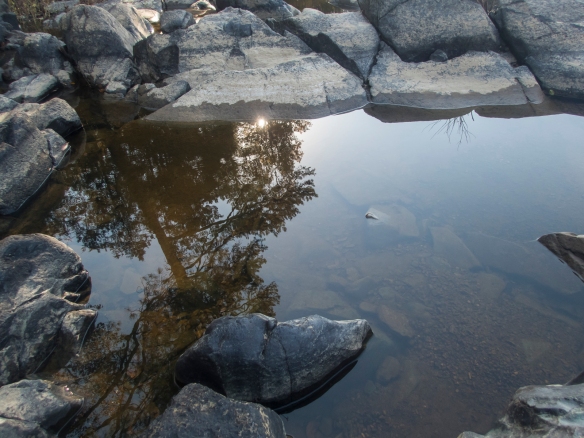The rivers flow not past but through us.
~John Muir

April is a beautiful time on the Haw (click photo to enlarge)
The Haw River flows along the boundary of the community where we live. It is a beautiful, rocky, river that flows 110 miles from its headwaters in Forsyth County, through Jordan Lake, to its confluence with the Deep River, where they combine to form the Cape Fear River. The Haw is also an important resource of recreation and drinking water for more than a million people in central North Carolina. Of course, it, and its river corridor, are also critical habitat for countless species in an area densely populated by humans. Over the years, the Haw has seen its share of pollution, from discharges from numerous textile factories a few decades ago, to runoff and nutrient overload from modern day development and other land altering practices within the river basin. The Haw River Assembly (HRA) has been educating people about, and helping to preserve, this valuable resource since its creation in 1982. I have always admired their work and diligence in standing up for the river. That is why I found myself joining a few other volunteers last Friday as we set out to do a stream monitoring assessment as part of HRA’s Haw River Watch Project.

Our monitoring site, just downstream from the Hwy 64 bridge
Our site is one that has been monitored off and on for several years. It is below the Hwy 64 bridge and easily accessible via a trail from the canoe access parking area.

The rest of our monitoring team doing chemical analyses
That is a good thing, since there is a bit of equipment to tote to your site – nitrate and phosphate test kits, petri dishes, magnifying lenses, a turbidity tube (for measuring water clarity), and a variety of nets and pans for sampling macro-invertebrates.

Juvenile northern water snake greeted us at our site
In addition to the water chemistry analyses, we survey the biology at our site. The primary assessment is for macro-invertebrates, which are used as indicators of water quality. But we are also take note of any other wildlife species. Shortly after we arrived, Elaine spotted a juvenile water snake sunning on a rock. Nearby was a small cloud of Eastern Tiger Swallowtails puddling for minerals along the bank of an island in the river channel.

Mayfly nymph pulled form underside of a rock in the river
But what we really wanted to learn was what was in the river, so most of us waded out into the water, sampling with nets as we went, and trying not to slip on the slick diatomaceous slime coating most of the boulders. This slippery surface is caused by a coating of algae and associated organic matter that coats the outside of underwater rocks and logs, especially in the slower moving portions of the river. It is an important food source for many macro-invertebrates, but can make for tricky footing for river monitors (it helps to have a long-handled net to brace yourself). I walked out a few steps and picked up a softball-sized rock in about a foot of water. Turning it over, I found two mayfly nymphs clinging to the underside. They were both very flattened, an ideal adaptation for living under rocks in swift water.

A mayfly nymph in the family Heptageniidae
Almost any small rock that could be turned over had one or more of these flattened bugs crawling about. As any trout fisherman knows, mayflies often constitute one of the primary food sources for fish in flowing waters. They belong to a family of insects called Ephemeroptera, derived from the Greek “ephemera”, meaning short-lived, referring to the short lifespans (hours or days) of most adult mayflies. North Carolina has over 200 species of these fascinating insects. As a group, they vary a great deal in size, shape, and habit, but can be distinguished from other macro-invertebrates by the presence of three (sometimes two) tail filaments, and gills along the sides of the abdomen.

Tiny mayflies were the most common invertebrate we netted
As it turned out, mayflies were, by far, the most abundant organism we collected.And most of them were very small ones that resembled this tiny guy. I am not sure, but I think it is a member of the family Baetidae, one of the most abundant types of mayflies in North Carolina.

Looking across the river at our sample site
Much of the river bottom is exposed rock outcrop and boulders with fast flowing water. Our most productive sampling occurred closer to shore or in areas with vegetation.

Underwater view of vegetation on a boulder in the river
I found myself going back to details I learned in classes I took years ago at Virginia Tech to try to identify (at least on a broad scale) many of the critters we uncovered. But a few things threw me and required some additional sleuthing. An early find resembled a globular egg mass on a tiny twig, but, when I discovered a more complete specimen, turned out to be a water-logged cluster of sweet gum flowers (duh). But another mystery proved to be something more worthwhile.

Small brown cases lined up on leaves of underwater vegetation
Some leaf fragments of some underwater plants ended up in my net and they had several small brown case-like structures adhered to them.

Closer view of cases
When I magnified the image back home, I could see white strands on one end of the case. This reminded me of the tracheal tube remains you see in a shed skin of a cicada nymph, so I assumed this was some sort of pupal case or shed skin of an aquatic critter.

A close up view of the underwater vegetation helped solve the mystery
When I took a closer look at the underwater image from the spot where these cases were collected, I saw a line of black flies lined up on one of the leaves. I then found some images online that suggests the cases are pupal cases of black flies.

Black fly larva
A few of our samples contained some of the distinctive fly larvae. The larvae produce a silk pad and then attach to it with tiny hooks on the tip of their abdomen.

A huge dragonfly nymph was the catch of the day
The best catch of the day was a huge dragonfly nymph. The broad abdomen of this species is diagnostic, and probably helps hide the nymph among the underwater bark and leaf debris it calls home.

Dragonhunter nymph
This is the distinctive aquatic stage of the dragonhunter, Hagenius brevistylus. Dragonhunters are the largest of the so-called clubtail dragonflies in the family Gomphidae. Adult dragonhunters, as the name implies, feed on other dragonflies and other large insects such as butterflies. The immature stage is easily recognized by the huge abdomen and “mickey mouse ears”, which are actually short, rounded antennae. The nymph is exceptionally long-lived, staying underwater for 4 or more years before emerging as a winged hunter.

Another dragonfly nymph
In that same spot, we found another, smaller, dragonfly nymph. Something we noticed about both of our dragonfly specimens was the abundance of tiny tubes covering their body.

Mystery tubes on dragonfly nymph
I’m not sure what they are, but they resemble the mud or silt tubes made by certain species of chironomid midge larvae. If anyone knows for sure, please drop me a note in the comment section. Our samples turned up quite a variety of macro-invertebrates, enough that the water quality index for this site was rated excellent. Below are a few more of the denizens of the Haw we found in our nets…

Large mayfly nymph, possibly in the family Isonychiidae

Caddisfly larva, family Hydropsychidae

Dobsonfly larva (also called a hellgrammite)

Shed skin of a stonefly nymph

Aquatic isopod
We will be sampling again in a few months and I can’t wait to see what we find. We all hope the river can maintain its beauty and diversity of life in the face of increasing pressures within the watershed. And we all owe a huge thank you to the many people and organizations (like the Haw River Assembly) that work so hard to help protect this, and the other waterways, of our state.
















































